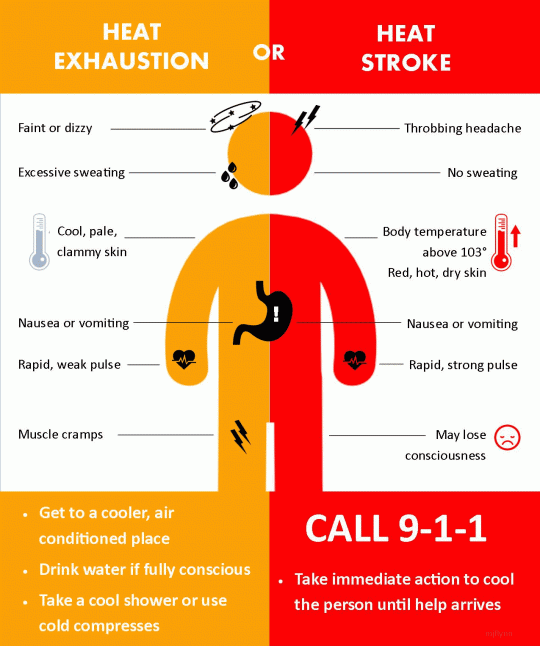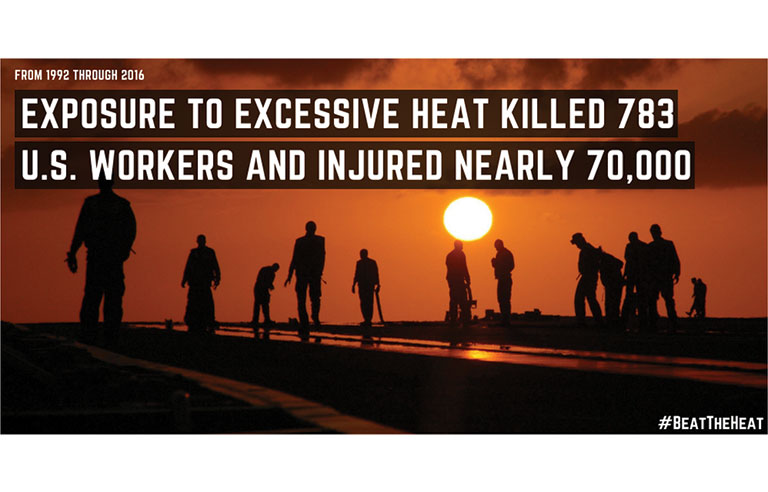Things to Know in the Summer Heat | Farmer Bob's Parts
Posted by Bobby the Farmhand on Dec 2nd 2020
Farming in the Summer Heat
Farmers, because of the nature of their profession, spend a lot of time outdoors in all types of weather especially in summer heat and humidity when crop production is in full swing. But while the sun helps sustain crops, its intense heat can cause potentially life-threatening illnesses. To protect themselves, farm workers should be familiar with the different heat-related illnesses, prevention steps, and medical responses to heat stress.

Causes of Heat-Related Illnesses
Heat-related illnesses results when one or more of the body's natural cooling mechanisms fail. The body has several ways of cooling itself. Conduction occurs when heat is transferred between two objects in contact with each other, such as when ice is applied to the skin. Convection occurs when air surrounding the skin is replaced by cooler air, which is why fans make it seem cooler. Evaporation rids our bodies of heat through sweat. Finally, radiation occurs when the body loses heat to cooler surroundings, which is why air conditioning cools us.
The human body's main defense against heat is perspiration which occurs when the surrounding environment is higher than the skin temperature. This response (a sympathetic nervous system reaction to the environment) allows the release of a chemical called acetylcholine that starts the sweat glands in the skin to release moisture and move it to the skin's outer surface for cooling. Unfortunately, in hot and humid weather, the moisture cannot always evaporate causing it to collect on the skin and increase the body's temperature and heart rate. When this occurs, the body sweats excessively draining the body of water and electrolytes which can result in a heat-related illness. The typical normal body temperature range is between 96 and 100 degrees F.

Who Is At Risk?
We are all at risk of sustaining a heat-related illness if we don't protect ourselves, but the following groups may run a higher risk of developing a heat-related illness:
Older populations
Infants
Individuals with certain medical conditions such as circulatory and/or heart problems or pregnancy
Individuals who are physically unfit or overweight
Individuals who have just consumed alcohol and/or drugs (including prescription medications)
Individuals with a lower heat tolerance level or those who have not fully acclimated to working in the heat
Individuals working in areas of high temperatures and humidity levels of specific environments (e.g., heat conducting surfaces)
Those workers that do not have adequate fluid intake levels.
Workers completing jobs in areas that have limited air flow to help with the cooling process.
Types of Heat-Related Illnesses
The following are the five heat-related illnesses listed from least to most severe:
Heat Rash
Heat rash is caused from excessive sweating during humid weather when sweat fails to evaporate from the skin and clogs pores. The most common symptoms of heat rash include red, blotchy skin or areas of pimples or small blisters. If severe, heat rash could develop into an infection. To prevent heat rash, wear clothing made from cool, breathable material, such as cotton. Keep your skin dry. If heat rash does develop, keep the area dry, treat it with corn starch and work in a cooler, less humid area.

Heat Syncope
Heat syncope, or fainting, affects people who aren't used to working in the heat or people who sit or stand for long periods of time. It is caused when the body pumps warm blood to the skin surface to remove heat via conduction, radiation, and convection. If a person remains sedentary, blood may pool in the lower body, reducing blood flow to the brain and causing fainting. It isn't serious, but it can be very scary to the victim or cause secondary injuries from falling.
If an outdoor worker faints, administer the following treatment: get the victim to a cool place, have them lie down, elevate their feet to facilitate blood re-circulation to the heart and brain, provide liquids to drink, and consult a doctor. Heat syncope can be prevented by moving around periodically when you are doing sedentary work outside, taking periodic breaks, and adjusting gradually to working in the heat.

Heat cramps
Heat cramps usually affect the stomach, arms and/or legs and can be excruciatingly painful. They are caused by a loss of body fluids and electrolytes via sweating, which can upset the body's chemical balance. Cramps can happen during or after physical activity. To treat them, drink lots of water and massage affected muscles. Do not eat salt tablet because too much salt in our system may aggravate heat illness. High salt intake causes the body to retain water instead of sweating it away.
Heat exhaustion
Heat exhaustion is caused by a loss of body fluids and salts from sweating, and decreased blood flow to the brain and other organs. Symptoms include cool, pale, clammy skin; dizziness; headaches; cramps; nausea or vomiting; weakness; confusion; or even unconsciousness. To treat heat exhaustion, move the victim to a cool place, remove excess clothing, elevate their feet, and call for emergency medical treatment. If the victim is able to drink, give them plenty of cool fluids while waiting for help to arrive.
Heat stroke
Heat stroke is a complete failure of the body's temperature-regulating mechanisms and a medical emergency. Symptoms include hot, dry skin; a 105-degree temperature or higher; confusion; anger; chills; nausea; dizziness; unconsciousness; convulsions; and delirium. In severe cases, the victim can become comatose. If not treated immediately, heat stroke may be fatal. Contact emergency medical professionals immediately if a person experiences any of these symptoms. While waiting for medical assistance, move the person to a cool place, remove the victim's outer clothing, slightly elevate their head and shoulder, and immerse them in cool water. If a pool of water is not available, sponge the victim's body with cold water until help arrives. Under these circumstances, do not give the victim anything to drink.

Preventing Heat-Related Illnesses
To prevent heat-related illnesses, following the guidelines below when working in the heat:
Drink approximately 8 oz. (1 cup) of water about every 15 - 30 minutes. (Note: Do not wait until you are thirsty to drink water!)
Avoid caffeine, alcohol, drugs and large amounts of sugar because they can speed up the dehydration process.
Wear lightweight, loose clothing and light colors that reflect sunlight.
Save strenuous work for the cool times of the day such as early morning or evening, and especially reschedule those tasks that require personal protective equipment.
Pace yourself and take 15 minute breaks in the shade every two hours.
Gradually adjust to working in the heat.
Check your prescription and over-the-counter medication to determine if there are side effects when exposed to heat.
Talk to your physician if you have a chronic health condition to obtain any special recommendations for working in hot and humid environments.
If you are a farm owner or manager, educate your workers about the prevention and emergency response of heat-related illnesses. Also observe your employees for heat related problems as well.
Change work schedules and routines as possible if the heat and humidity index may exceed 105-degrees F.

Summary
Heat-related illnesses can be potentially dangerous and life-threatening to those individuals in a farming community but they can be prevented. When working outdoors in the heat, drink plenty of water before and during work activities, take breaks in a shaded area, pace yourself, and gradually adjust to working in the heat. Below is a summary reference chart that outlines the illness, symptoms, and treatment information presented above.
Heat Illness Symptoms Proper Treatment
Heat Rash Red, blotchy skin rash or areas with clusters of pimples or small blisters. Affected area should be kept dry, and treat with corn starch or powder. Rest in a cool place.Heat Syncope Lightheaded, fainting, or dizziness Move victim to a cool place; they should lie down and elevate their feet. Give the victim plenty of cool fluids.
Heat Cramps Pain in stomach and/or legs Stop activity and drink plenty of water. Massage affected muscles.
Heat Exhaustion Cool, pale, clammy skin; dizziness; headache; cramps; nausea or vomiting; weakness; confusion or unconsciousness. If conscious, give plenty of cool fluids. Remove excess clothing and apply cool compresses. Contact emergency medical services.
Heat Stroke Hot, dry skin; temperature of 105 degrees or higher; confusion; anger; chills; nausea; dizziness; unconsciousness, convulsions; and delirium. Immediately contact emergency medical services. Move the person to a cool place and keep their head and shoulders elevated. Remove outer clothing and cool the body (e.g., cool water,wet towels or sheets, or immersion).
Resources
Heat-related illnesses and agricultural producers. (2012) Farm and Ranch eXtension in Safety and Health (Fresh) Community of Practice.

